Today, design is seen as a key function inside many organizations. For recently-minted designers, this statement may seem trite. “Of course design matters,” they will wonder. “Why wouldn’t it have a key role in the creation of products and services?” Well, design wasn’t always as central to business as it is today. Many people (including me) attribute design’s current prominence to Apple’s resuscitation in the late 1990s, its emergence from the ashes, and eventual domination of the tech market and beyond.

Wired magazine cover from June 1997.
Design played a central role in Apple’s comeback, and the business press gave it its due. But before this, many people inside organizations saw design as being in service to either marketing or surface decoration. One result of Apple’s back-from-the-dead story is that many large organizations today value design — and not just in the superficial sense of making things more attractive, but in the deeper sense of design as engine of coherence, engagement, innovation, and brand loyalty.
Still, design is relatively young as an internal organ of businesses. Many organizations are experimenting with different ways of structuring their design operations. What the “right” structure is varies; organizations that primarily provide services will have different needs than those that create products, as will those that serve consumers versus other businesses. Also, many organizations offer a mix of products and services, so one size doesn’t fit all even within an individual company.
Internal design organizations must serve various roles. At the most basic level, they must ensure that the organization’s products and services are coherent, useful, and delightful. In the past, companies hired external design consultancies to do this for them; even Apple famously hired Frogdesign to design the Apple IIc and the Snow White design language. For product-centric organizations today, it seems inconceivable to delegate this function to external designers.
Design also plays another important role in organizations: to help leadership see their context clearly and map viable courses of action within it. This function is often referred to as design strategy or strategic design. Following the trend of moving design internally, many organizations have also internalized this design function (often within innovation groups).
It’s natural for “experience”-level designers (the ones who work on the organization’s products, services, and information environments) to be internal, since they create intellectual property that differentiates the company from its competitors. However, strategy-level designers have a different remit: they’re called to reduce ambiguity, to see the playing field clearly, to elucidate new ways for the organization to be in the world.
You can’t see clearly if you’re beholden to the forces that affect the other internal organs of the company, the ones maintaining homeostasis. Strategy-level designers must often function as provocateurs, making tangible new (and potentially scary!) directions for the organization. You can’t do that effectively without the freedom to step on some toes.
That’s not to say there’s no role for internal strategic designers. By definition, internal designers are closer to the organization’s problem space than external designers. Instead, a partnership between internal and external resources is called for: one that leverages the vertical understanding (mission, purpose) the former bring to the practice, with the horizontal understanding (cross-pollination from other industries, freedom from internal politics) that only the latter can provide. A mix of internal and external design resources allows organizations get a clearer sense of where they are and where they can go from there.